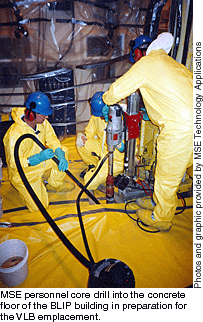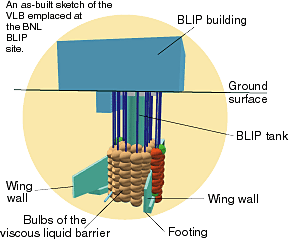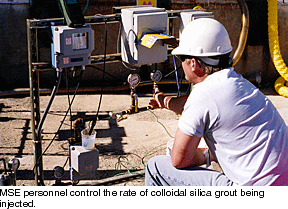
The soils underlying the BLIP building were contaminated as a result of isotope production for medical and research purposes. The contamination extends about 6.5 feet outward from a tank under the building and includes about 95 cubic yards of activated soil. The barrier, which was installed as part of a interim action under Superfund, is designed to encapsulate the activated soil and prevent rainwater from seeping through.
Mary North-Abbott, MSE project manager for the VLB project at Brookhaven, described how it’s possible to build a barrier with a material that emerges from the drill string with the viscosity of water. From 90 to 120 minutes after colloidal silica is mixed aboveground with calcium chloride, an electrolyte, the CS mixture begins to gel. While the CS is reacting with the electrolyte and is still a liquid, it’s injected into the subsurface, where it begins to gel shortly thereafter. "The idea is to pump the grout down to the desired location while it’s the consistency of water, then for it to gel before it has an opportunity to seep or flow further." This completes one injection cycle, which North-Abbott refers to as a "bulb," a reference to the resultant shape, a slightly flattened sphere. Columns of CS material are built as more bulbs are stacked below the surface. "We injected a series of bulbs—each created with a predetermined quantity of material. We controlled how much we pumped down there to control the size of the bulb. Then the process is repeated by pushing down to the next horizon and doing the same thing again." North-Abbott also explained how previous lab and field work contributed to MSE’s knowledge of how CS behaves underground. "We demonstrated it first in big sand tanks in the laboratory. We packed the tanks with sand from BNL, put them into a load cell (large press), and applied pressures that would simulate those experienced at 30 feet below ground surface. Once the injected grout material was cured, we tested samples and then excavated the sand in the tanks to see the actual size and shape of the bulbs." The CS material was emplaced using permeation grouting, a low-energy and minimally invasive method of injection that doesn’t disturb the soil matrix or damage structural features like tanks, pipes, or cables. The low pressures of permeation grouting—plus the fact that CS gels around infrastructure like the BLIP tank, piping, and footings—mean that installation of a VLB can be less problematic at facilities where existing structures must be protected. VLB is one part of protection packageThe VLB isn’t the only structure protecting BNL groundwater. In conjunction with this project, Brookhaven personnel have bolstered their stormwater control system to lower the possibility of runoff infiltrating through the unsaturated zone to reach the BLIP tank and surrounding soils. A gunite cap at ground surface was upgraded, and stormwater drains and gutters have been moved to reroute rainwater flow. Is it working? The objective of this project is to limit rainwater flux through BNL’s sandy activated soils. BNL personnel and regulatory agencies agreed that the water flux through the activated soils should be reduced from 1 foot/year to less than 0.13 feet/year. This project seeks to reduce flux by using CS grout to effect changes in saturated hydraulic conductivity values and in the physical properties of the soil. Soil laboratory measurements and flow modeling performed prior to the barrier’s installation demonstrated that flux could be reduced 23 times lower than the objective set by regulators. To avoid sampling the actual barrier and destroying it in the process, MSE is using a test barrier that the company installed adjacent to the BLIP building and at a slightly shallower depth just prior to the construction of the actual barrier. The test barrier, consisting of three columns of three bulbs each, was formed with the same materials and construction process that MSE used for the actual barrier. MSE has adopted a wait-and-see attitude. An early set of permeameter tests was performed about 60 days following installation to determine if lower subsurface temperatures were affecting the grout’s gel time. With these early tests, MSE validated that the cooler subsurface temperature was slowing gel time and that it would be necessary to run a set of tests after the grout had fully cured. "Because of the colder temperatures in the subsurface, we don’t feel it has cured long enough. We didn’t get the results that CS is capable of achieving, so we’ll wait and test again. This also happened in the lab. Once the grout enters the subsurface, it just takes longer to cure." The higher hydraulic conductivity data was also anticipated because the permeameter test locations were on the outer edges of the test barrier. "The outer edges of the barrier and the intersections of the grout bulbs are the worst case areas to test. They are likely to have higher hydraulic conductivity values because that part of the barrier is on the fringe of the bulb, where the grout doesn’t completely fill the pore space. In contrast, the central part of a bulb, near the injection point, which we will test during the next effort, should have a lower hydraulic conductivity." MSE and the Subsurface Contaminants Focus Area have high hopes for this new technology and its ultimate application at other DOE sites where radiologically contaminated areas require some type of interim or long-term containment. Based on estimates from a cost model MSE previously developed for DOE, costs for this low-maintenance technology are approximately six times less than that for the baseline of excavation and disposal. Another advantage of the technology is that a VLB is emplaced using a low-energy delivery system, which prevents damage to fragile infrastructure, lowers the risk of bringing contaminants to the surface, and minimizes worker exposure. North-Abbott is happy to have reached this critical juncture in the technology’s life. "It was really exciting to finally, after all these years, complete the field work and for it to go so well." She credits the combined efforts of the Brookhaven site support team and the MSE emplacement team. "DOE’s Brookhaven Area Office helped tremendously with regulator approval and put up funds for site management, while the BNL Environmental and Waste Technology Center managed rad testing, site coordination and logistics, and permitting. MSE performed VLB emplacement, QA/QC testing, and as-built/design modifications. We worked well together and finished about two weeks earlier than expected. Not counting the time to construct the test barrier, we spent 12 days injecting CS after we entered the BLIP building and went hot." For more information about the installation of a viscous liquid barrier project at Brookhaven National Laboratory, see http://www.dne.bnl.gov/ewtc/blip.htm, or contact Mary North-Abbott at (406) 494-7279, northabb@mse-ta.com or Andrea Hart at (406) 494-7410, ahart@mse-ta.com.
|
 A project
supported by the
A project
supported by the  whose development and demonstration the focus area
has supported since FY96 (see
whose development and demonstration the focus area
has supported since FY96 (see  Although
Although 